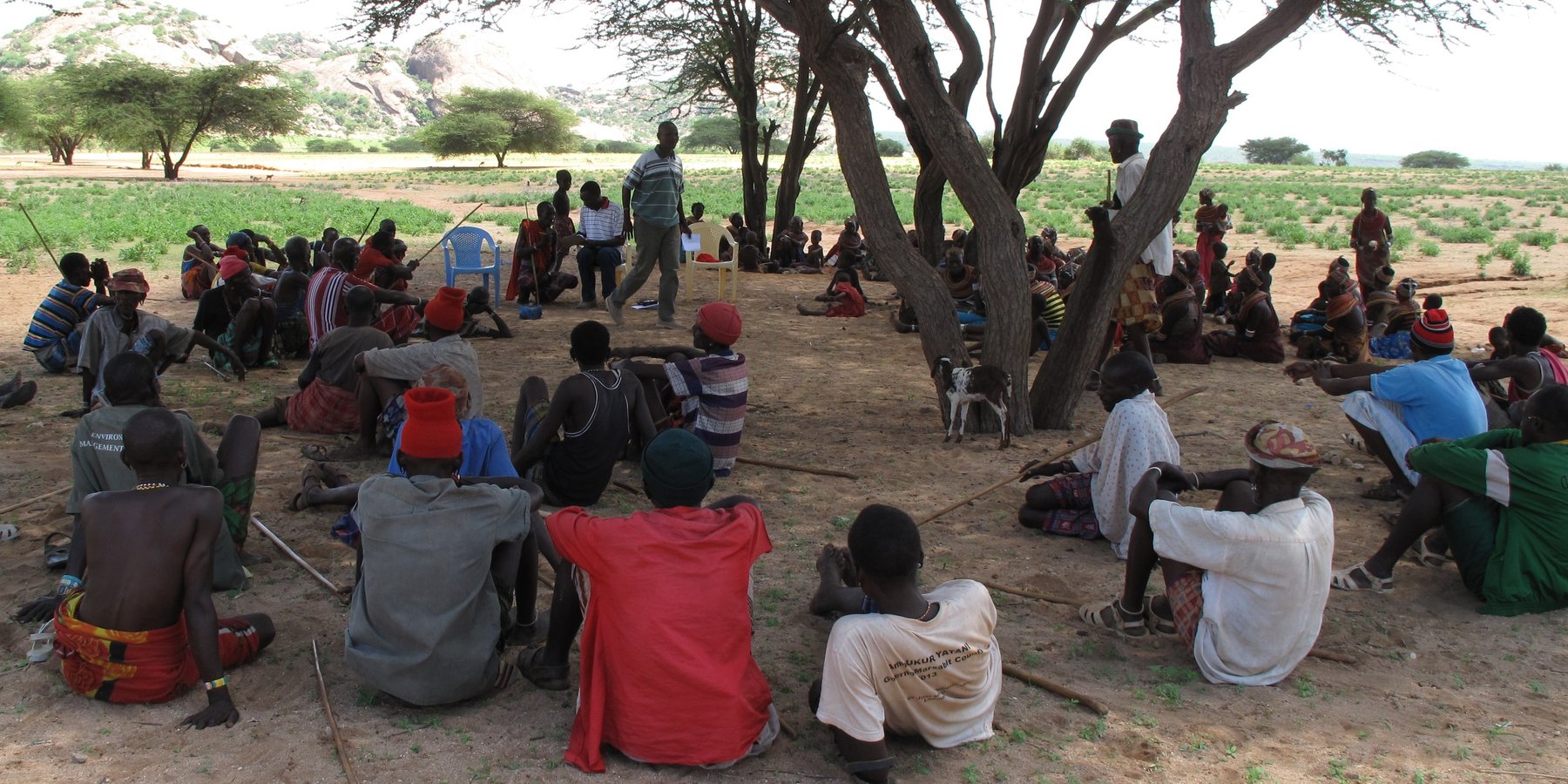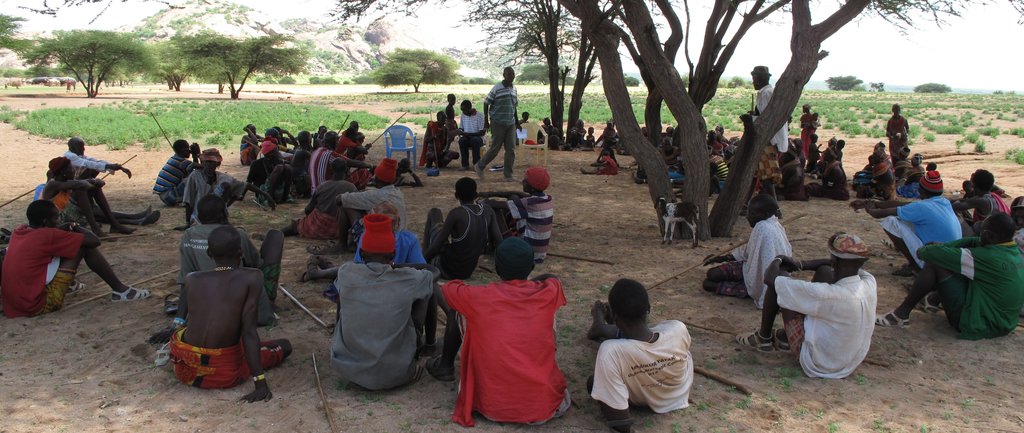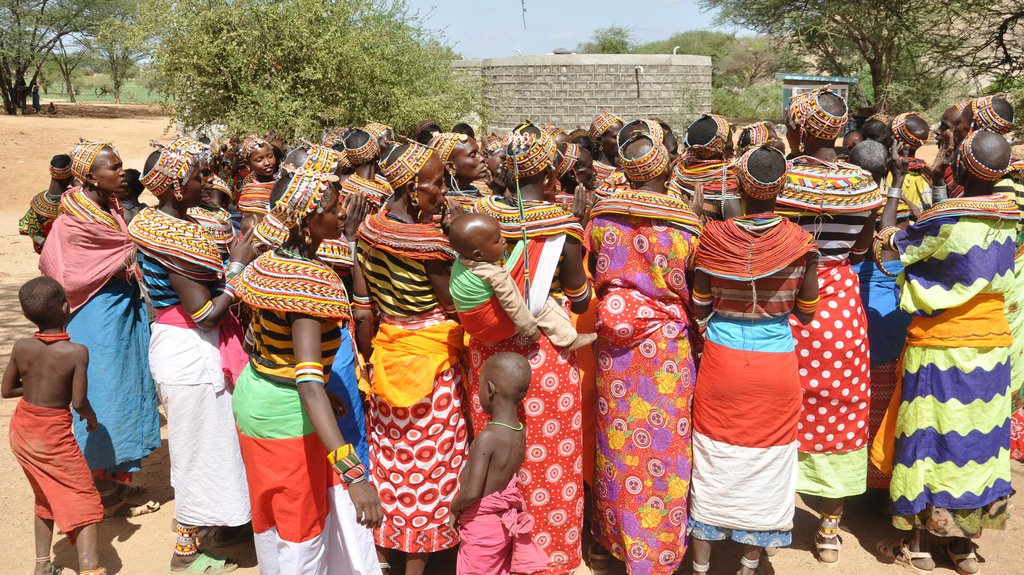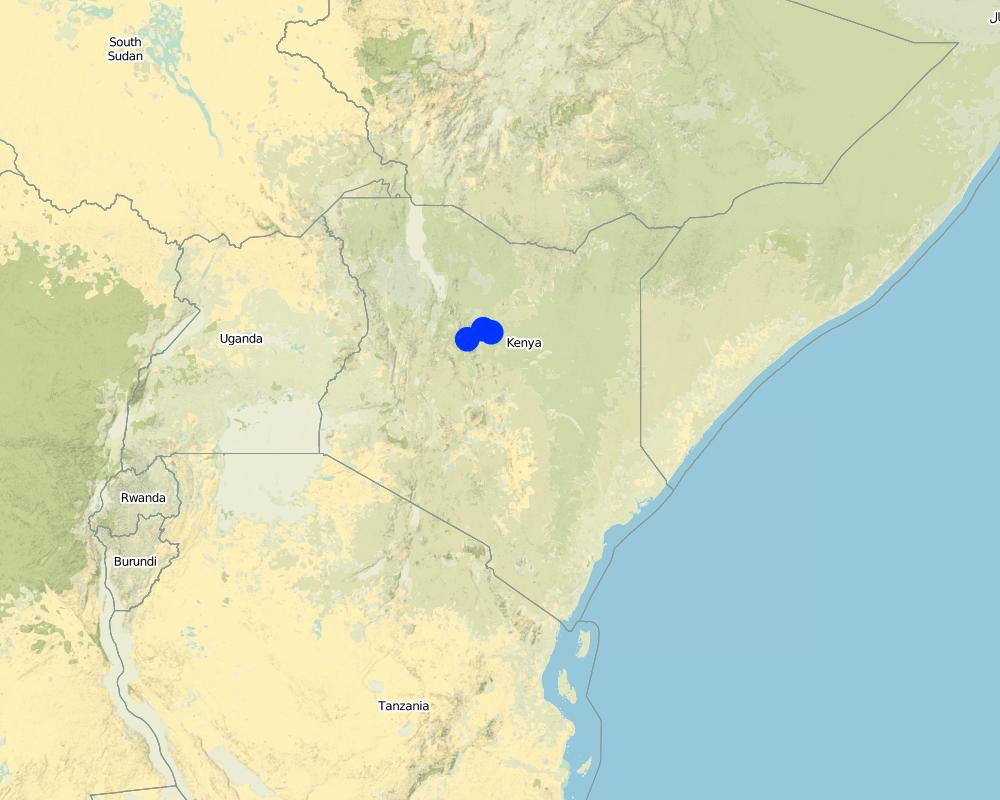Partnership with beneficiary communities in project implementation [كينيا]
- تاريخ الإنشاء:
- تحديث:
- جامع المعلومات: Fredrick Ochieng
- المحررون: Nicole Stolz, Boris Orlowsky
- المراجعون: Alexandra Gavilano, Boris Orlowsky, Renate Fleiner
N/A
approaches_597 - كينيا
عرض الأقسام
توسيع الكل طي الكل1. معلومات عامة
1.2 تفاصيل الاتصال بالأشخاص الرئيسيين لمصدر المعلومات والمؤسسات المعنية بتقييم وتوثيق النهج
الشخص (الأشخاص) الرئيسي لمصدر المعلومات
Fredrick Ochieng:
كينيا
اسم المشروع الذي سهّل توثيق/تقييم النهج (إذا كان ذلك على صلة)
Book project: where people and their land are safer - A Compendium of Good Practices in Disaster Risk Reduction (DRR) (where people and their land are safer)اسم المؤسسة (المؤسسات) التي سهلت توثيق/تقييم النهج (إذا كان ذلك على صلة)
CARITAS (Switzerland) - سويسرا1.3 الشروط المتعلقة باستخدام البيانات الموثقة من خلال WOCAT
متى تم تجميع البيانات (ميدانيا)؟:
14/10/2016
يوافق جامع المعلومات والشخص (لاشخاص) الرئيسي لمصدر المعلومات على الشروط المتعلقة باستخدام البيانات الموثقة من خلال WOCAT:
نعم
1.4 المراجع الخاصة باستبيان(استبيانات) تقنيات الإدارة المستدامة للأراضي

Rock catchment [كينيا]
A rock catchment system is a water harvesting structure comprising a bare sloping rock surface (impounded area), a constructed concrete wall at a strategic point (weir), pipeline from the weir to the storage tank(s), storage tanks and water kiosk(s) connected to the water tanks by pipelines.
- جامع المعلومات: Fredrick Ochieng
2. وصف نهج الإدارة المستدامة للأراضي
2.1 وصف موجز للنهج
The approach focuses on community engagement on a partnership basis. The model is a departure from the traditional approaches where the community mostly is reduced to being a beneficiary of project services without substantive responsibility.
2.2 وصف تفصيلي للنهج
وصف تفصيلي للنهج:
The Approach is hinged on community empowerment and partnership. The model is a departure from the traditional approaches where the community is reduced to a mere beneficiary of project services without substantive responsibility.
The main purpose of the approach is to enhance ownership, while fostering needed capacity for management of project outcomes. Ultimately, it is estimated that sustainability of project results is achievable with good community empowerment and meaningful participation. The approach also aims at cost effectiveness as the community is required to substantially contribute locally available materials, labour and sometimes cash.
Community mobilisation and capacity building is central to ensure that the community is prepared to undertake their roles and responsibilities. Mobilisation happens through discussions, sometimes aided by applying participatory tools and methods. Capacity building is done through workshop-type and/or on-the-job training. It is noteworthy that the communities do have indigenous knowledge and skills which are useful in processes of development at the community level. These skills and knowledge inform the project design, planning and implementation of activities. To enhance local skills, selected community members are trained as they work alongside the hired skilled artisans during the construction of the rock catchment system. The aim is to prepare and equip the locals with basic skills for operations and maintenance of the rock catchment system. Others are trained to get equipped with skills on hygiene and sanitation promotion.
The project was designed based on pre-project assessment. The assessment, besides identifying water and hygiene needs, also identified three areas/communities which had rock catchment potential - Ndikir, Manyatta Lengima and Mpagas. Initial meetings were done with support from community leaders and the local government administrators (chiefs). During the meetings the project was explained and discussed in view of the community needs and the roles for all stakeholders - Caritas Switzerland (CACH), the community, government and leaders. Agreed roles and responsibilities were drafted and formed the main part of the memorandum of understanding (MOU) between CACH and the community. The MOU was signed before the entire community for collective ownership and formalise the relationship between CACH and the project.
At the county and sub-county level, the stakeholders are provided with progress updates, engaging with government and other leaders. The local leaders were useful in helping in community mobilisation and addressing areas of concern wherever issues arose.
The approach left the community more motivated with a desire to manage the project benefits for posterity. The community has appreciated that the project ended with a number of community members having acquired basic skills for operations and maintenance. Above all, they were proud that they significantly contributed to the successful implementation of the project. Initially the community were opposed to the idea that they had to contribute so much, since before they had mostly received assistance without any requirement on their side to contribute.
2.3 صور عن النهج
2.4 فيديوهات عن النهج
تعليقات، وصف موجز:
The video is taken on an early morning shower and shows how water is collected, dammed and channelled downstream to the masonry tanks.
التاريخ:
08/12/2014
الموقع:
Ndikir village, Marsabit County, Kenya
اسم مصور الفيديو:
Fredrick Ochieng
2.5 البلد/المنطقة/المواقع التي تم تطبيق النهج فيها
البلد:
كينيا
المنطقة/الولاية/المحافظة:
Laisamis sub county, Marsabit County, Kenya
مزيد من التفاصيل حول الموقع:
Implemented with three different communities in three locations, Ndikir, Manyatta Lengima and Mpagas
Map
×2.6 تواريخ بدء وإنهاء تنفيذ النهج
أشر إلى سنة البدء:
2013
سنة الإنهاء (إذا لم يعد النهج مطبقًا):
2015
التعليقات:
The Rock catchment project was implemented from 2013 to 2015
2.7 نوع النهج
- قائم على مشروع/برنامج
2.8 الغايات/الأهداف الرئيسية للنهج
1. Community mobilisation
2. Active community participation and ownership of the project and outcomes
3. Sustainability of the project outcomes
4. Enhanced skills and capacity to manage the Technology
2.9 الظروف التي تمكن أو تعيق تنفيذ التقنية/التقنيات المطبقة بموجب النهج
المعايير والقيم الاجتماعية /الثقافية/ الدينية
- معيق
The community was accustomed to receiving food and non-food handouts. This culture was a major huddle in working with community where they were expected to make substantial contribution towards the project activities.
الإطار المؤسساتي
- تمكين/تمكيني
The institutional setting, especially the traditional authority of elders, was supportive during implementation. Once the elders were convinced and persuaded to make certain decisions beneficial to the project, it was always easier for the rest of the community members to rally behind.
التعاون/التنسيق بين الجهات الفاعلة
- تمكين/تمكيني
The Approach requires that stakeholders (other non-state actors and government) coordinate well so that approaches employed by all are complementary and all build into sustainable results. It is common however that there have been approaches that dis-empower communities. Good coordination and collaboration would enhance sharing and learning across the actors and minimise such programming pitfalls.
الإطار القانوني (حيازة الأراضي، وحقوق استخدام الأراضي والمياه)
- تمكين/تمكيني
Land tenure in the northern Kenya is mostly communal. This was an enabling factor so that there were no complex and usual elaborate and expensive legal requirements to construct a rock catchment water system. Had land been adjudicated and subdivided for individual ownership, there would have been a need for negotiations and legal procedures to be done with those who own the land where the public asset is to be located.
3. المشاركة وأدوار الأطراف المعنية
3.1 أصحاب المصلحة المعنيون بالنهج وأدوارهم
- مستخدمو الأراضي المحليون/المجتمعات المحلية
The project was implemented with participation of the communities who are the local land users
Community's role was to ensure that locally available materials were delivered on the site of construction, hygiene and sanitation promotion, unskilled labour, record keeping of all construction materials, security of workers and construction materials on site
- متخصصون في الإدارة المستدامة للأراضي / مستشارون زراعيون
Caritas had a technical team of three staff who were based within the project location in the field. This team was supported through experts in the office in the capital city Nairobi.
The technical team implemented all project activities such as community organisation/mobilisation, construction of infrastructure as well as hygiene and sanitation promotion.
- الحكومة المحلية
Chiefs, Members of County Assembly, Ward administrators
Opinion leaders were critical in the process of community mobilisation and following-up the commitments made by the community under the signed MoU.
- الحكومة الوطنية (المخططون، صانعو القرار)
County Steering Group (CSG), sub-County Steering Group (SCSG)
Coordination with other development agencies and government departments at the County level
- منظمة دولية
Caritas Switzerland
Overall leadership in project planning, implementation and supervision
3.2 انخراط مستخدمي الأراضي المحليين/المجتمعات المحلية في المراحل المختلفة للنهج
| انخراط مستخدمي الأراضي المحليين/المجتمعات المحلية | حدد من شارك وصف الأنشطة | |
|---|---|---|
| المبادرة/التحفيز | تفاعلي | Planning for project activities was jointly planned between the community and the project staff specialists |
| التخطيط | تفاعلي | More technical planning was done as advised by the technical project team. Planning for day to day field activities during implementation was jointly done with the community |
| التنفيذ | تفاعلي | Community participation was more interactive in planning for specific project activities. However, there were specific tasks which required hired labour and by common agreement the community provided such labour for payment. |
| الرصد/التقييم | تفاعلي | Monitoring with community was mainly done during project reflection/review meetings. Monitoring in this respect was more limited to evaluation of project activities progress and timeliness with which the activities were being achieved. |
3.3 مخطط التدفق (إذا كان متاحًا)
الوصف:
The flow chart summarises the Approach's key components, activities and steps for community mobilisation, capacity building and stakeholders engagement. The stakeholders include the relevant government departments - Water, Health, Environment, Drought Management - and non-state actors in the County. There is a monthly forum known as the County Steering Group (CSG) which brings together all the heads of government departments and NGO representatives at the county level. Similar forums also take place at the sub-county level.
المؤلف:
Fredrick Ochieng
3.4 اتخاذ القرار بشأن اختيار تقنية/تقنيات الإدارة المستدامة للأراضي
حدد من الذي قرر اختيار التقنية/التقنيات التي سيتم تنفيذها:
- جميع الجهات الفاعلة ذات الصلة، كجزء من نهج تشاركي
اشرح:
The project was designed initially without direct community involvement other than the pre-project information collected.
حدد على أي أساس تم اتخاذ القرارات:
- تقييم المعرفة الموثقة جيدًا بشأن الإدارة المستدامة للأراضي(اتخاذ القرارات القائمة على الأدلة)
- نتائج البحوث
- خبرة وآراء شخصية(غير موثقة)
- Government policies
4. الدعم الفني وبناء القدرات وإدارة المعرفة
4.1 بناء القدرات/التدريب
هل تم تقديم التدريب لمستخدمي الأراضي / الأطراف المعنيين الآخرين؟:
نعم
حدد من تم تدريبه:
- مستخدمو الأراضي
- موظفون ميدانيون/ مستشارون
شكل التدريب:
- في العمل
- مناطق العرض
المواضيع المغطاة:
Basic construction skills, management of water system (rock catchment), hygiene and sanitation promotion
4.2 خدمة استشارية
هل يملك مستخدمو الأراضي وصولا إلى خدمة استشارية؟:
نعم
حدد ما إذا كانت الخدمة الاستشارية متوفرة:
- في حقول مستخدمي الأراضي
وصف/تعليقات:
The community has (in theory) access to government advisory services. However, the nearest government offices are about 20-50 kilometres away without reliable means of transport. The technical staff of the county government is often unable to offer quality and effective extension work, mostly due to transport limitations but also due to low motivation. However, this gap is being bridged through the work of various NGOs operating in the region who provide advisory services in addition to other interventions such as in water, health, livelihoods, and education.
4.3 تعزيز المؤسسات (التطوير التنظيمي)
هل تم إنشاء أو تعزيز مؤسسات من خلال هذا النهج؟:
- نعم، باعتدال
حدد المستوى (المستويات) التي تم فيها تعزيز أو إنشاء المؤسسات:
- محلي
صف المؤسسة والأدوار والمسؤوليات والأعضاء وما إلى ذلك.
The Approach led to establishment of Water Management Committees. The committees have been trained and equipped to manage the systems.
حدد نوع الدعم:
- مالي
- بناء القدرات/التدريب
- معدات
اعط مزيدا من التفاصيل:
One key lesson from this and other projects is that one-off trainings are rarely effective even if properly done. A continuous support/follow-up is necessary to maintain the skills and knowledge acquired.
4.4 الرصد والتقييم
هل يشكل الرصد والتقييم جزءا من النهج؟:
كلا
4.5 البحوث
هل كانت البحوث جزءًا من النهج؟:
كلا
5. التمويل والدعم المادي الخارجي
5.1 الميزانية السنوية لمكون الإدارة المستدامة للأراضي في النهج المذكور
إذا لم تكن الميزانية السنوية الدقيقة معروفة، قم بالإشارة إلى نطاقها:
- 10,0000-2,000
التعليقات (على سبيل المثال المصادر الرئيسية للتمويل/الجهات المانحة الرئيسية):
Internal organisational funding and external donors
5.2 الدعم المالي/المادي المقدم لمستخدمي الأراضي
هل حصل مستخدمو الأراضي على دعم مالي/ مادي لتنفيذ التقنية/ التقنيات؟:
نعم
إذا كانت الإجابة بنعم، حدد نوع (أنواع) الدعم والشروط والمزودين:
Caritas procured the bulk of construction materials whereas the community contributed locally available materials - sand and hardcore stones
5.3 إعانات لمدخلات محددة (بما في ذلك العمالة)
إذا كان العمل من قبل مستخدمي الأراضي مدخلاً جوهريًا، فهل كان:
- تطوعي
التعليقات:
The labour contribution was split between the organisation and the community. Caritas paid 3 USD per day whereas the standard amount per day is 5 USD. This was discussed and agreed at the inception of the project. The consideration was that those who work on site will not have any other time for other work for their household daily needs.
5.4 الائتمان
هل تم توفير ائتمان في إطار نهج أنشطة الإدارة المستدامة للأراضي؟:
كلا
5.5 حوافز أو وسائل أخرى
هل تم استخدام حوافز أو أدوات أخرى لتشجيع تنفيذ تقنيات الإدارة المستدامة للأراضي؟:
كلا
6. تحليل الأثر والتصريحات الختامية
6.1 آثار النهج
هل ساهم النهج في تمكين مستخدمي الأراضي المحليين وتحسين مشاركة الأطراف المعنية؟:
- لا
- نعم، قليلا
- نعم، باعتدال
- نعم، إلى حد كبير
Community's participation was initially a new concept for the communities in this region. Through various meetings, persistency and flexibility the community participation improved and was achieved during the project period.
هل مكّن النهج من اتخاذ القرارات المبنية على الأدلة؟:
- لا
- نعم، قليلا
- نعم، باعتدال
- نعم، إلى حد كبير
Due to the nature of working with the community, it was always possible to review certain elements of project activities based on learning
هل ساعد النهج مستخدمي الأراضي على تنفيذ وصيانة تقنيات الإدارة المستدامة للأراضي؟:
- لا
- نعم، قليلا
- نعم، باعتدال
- نعم، إلى حد كبير
The Approach's aim was to build the required capacity of the community members to better manage the Technology well after the project ends.
هل نجح النهج في تحسين التنسيق والتنفيذ الفعال من حيث التكلفة لأنشطة الإدارة المستدامة للأراضي؟:
- لا
- نعم، قليلا
- نعم، باعتدال
- نعم، إلى حد كبير
Community's contribution in labour and locally available materials (hardcore stones and sand) significantly reduced the cost of construction. These are materials that otherwise would have been procured from far off sources at a much higher cost.
هل نجح النهج في تعبئة/تحسين الوصول إلى الموارد المالية لتنفيذ الإدارة المستدامة للأراضي؟:
- لا
- نعم، قليلا
- نعم، باعتدال
- نعم، إلى حد كبير
The SLM was implemented with funding support aimed for drought recovery. The country had just gone through a major drought. The Approach, however, focused more on mobilising communities towards meaningful participation by providing local available resources such as hardcore, sand, and unskilled labour.
هل أدى النهج إلى تحسين معرفة وقدرات مستخدمي الأراضي على تنفيذ الإدارة المستدامة للأراضي؟:
- لا
- نعم، قليلا
- نعم، باعتدال
- نعم، إلى حد كبير
A significant element of the Approach was capacity building which was achieved through on-the-job and workshop training for the selected community members
هل أدى النهج إلى تحسين معرفة وقدرات الأطراف المعنية الأخرى؟:
- لا
- نعم، قليلا
- نعم، باعتدال
- نعم، إلى حد كبير
The project was implemented with close involvement of county government officials and other development organisations. There have been requests by other development actors in the region wanting to know more about how Caritas Switzerland succeeded in working with the communities and achieving these impressive results.
هل ساهم النهج في بناء/تعزيز المؤسسات والتعاون بين الأطراف المعنية؟:
- لا
- نعم، قليلا
- نعم، باعتدال
- نعم، إلى حد كبير
The project's mandate was limited to community institutions capacity building. Beyond community empowerment the Approach did not target to raise capacity of other stakeholders.
هل ساهم النهج في التخفيف من حدة الصراعات؟:
- لا
- نعم، قليلا
- نعم، باعتدال
- نعم، إلى حد كبير
The region within which the project was implemented in has resource based conflicts, mostly conflicts over water and pasture land. The Approach led to successful implementation of the Technology which reduces pressure on water resources. In addition, the management of the newly constructed water points ensures that community members benefits equally
هل ساهم النهج في تمكين الفئات المحرومة اجتماعيا واقتصاديا؟:
- لا
- نعم، قليلا
- نعم، باعتدال
- نعم، إلى حد كبير
Women are the main beneficiaries of the Approach. They were more active than men in offering semi-voluntary labour. Their motivation was that they bear the greater burden than men as it is their responsibility to provide household water .
هل شجع النهج الشباب/الجيل القادم من مستخدمي الأراضي على الانخراط في الإدارة المستدامة للأراضي؟:
- لا
- نعم، قليلا
- نعم، باعتدال
- نعم، إلى حد كبير
Youth participation was minimal due cultural barriers. Young men do not participate in most of community activities. They are expected to have minimal contact with the rest, and especially women hence most of their time they are in the bush
هل أدى النهج إلى تحسن في مسائل حيازة الأراضي / حقوق المستخدمين التي أعاقت تنفيذ تقنيات الإدارة المستدامة للأراضي؟:
- لا
- نعم، قليلا
- نعم، باعتدال
- نعم، إلى حد كبير
Land tenure system in the area where the Approach was implemented is communal.
هل أدى هذا النهج إلى تحسين الأمن الغذائي / تحسين التغذية؟:
- لا
- نعم، قليلا
- نعم، باعتدال
- نعم، إلى حد كبير
It is expected that nutritional status will improve with increased access to better quality water. However, no survey was carried out to confirm this assumption.
هل أدى النهج إلى تحسين الوصول إلى الأسواق؟:
- لا
- نعم، قليلا
- نعم، باعتدال
- نعم، إلى حد كبير
Community members who initially would spend substantial amount of time to search for water now have more time freed to engage in trade and other diversified sources of income
هل أدى النهج إلى تحسين الوصول إلى المياه والصرف الصحي؟:
- لا
- نعم، قليلا
- نعم، باعتدال
- نعم، إلى حد كبير
There is improved access to water. The three benefiting communities no longer need water supply emergency. However, impact on sanitation was less than satisfactory.
هل أدى النهج إلى استخدام طاقة/ مصادر طاقة أكثر استدامة؟:
- لا
- نعم، قليلا
- نعم، باعتدال
- نعم، إلى حد كبير
The project's mandate under which the Approach was implemented was limited to water and sanitation
هل أدى النهج إلى تحسين قدرة مستخدمي الأراضي على التكيف مع التغيرات المناخية/الظواهر المناخية المتطرفة والتخفيف من الكوارث المرتبطة بالمناخ؟:
- لا
- نعم، قليلا
- نعم، باعتدال
- نعم، إلى حد كبير
Increased water supply has greatly increased community's resilience to droughts. With a prudent management of water harvested, they have successfully avoided negative drought impacts.
هل أدى النهج إلى توفير فرص عمل ودخل؟:
- لا
- نعم، قليلا
- نعم، باعتدال
- نعم، إلى حد كبير
There is no direct employment except that the community members can now engage more in other rewarding businesses
6.2 المحفز الرئيسي لقيام مستخدمي الأراضي بتنفيذ الإدارة المستدامة للأراضي
- الحد من مخاطر الكوارث
Increased water supply has greatly decreased community's vulnerability to droughts.
- انخفاض عبء العمل
The community was highly motivated by the challenges of acute and perennial water shortages they have experienced for many years. They had a great desire to change and overcome this challenge.
- التخفيف من حدة الصراع
Reducing water scarcity likely leads to less conflict on water. However, no survey data is available to validate this assumption.
- improved water acess
6.3 استدامة أنشطة النهج
هل يمكن لمستخدمي الأراضي المحافظة على استدامة ما تم تنفيذه من خلال النهج (بدون دعم خارجي)؟:
- نعم
إذا كانت الإجابة بنعم، صف كيف:
The Approach greatly focused on capacity building, community empowerment and strengthened institutions. It is expected therefore that they will sustainably manage the Technologies that have been constructed.
6.4 نقاط قوة/مزايا النهج
| نقاط القوة/ المزايا/ الفرص من وجهة نظر مستخدمي الأراضي |
|---|
| The Approach leads to greater ownership of the technology thus leading to better equipped community groups with skills for operations and maintenance. The Approach galvanises a community towards a common goal hence promotes cohesion and better organisation. |
6.5 نقاط الضعف/ العيوب في المنهج وطرق التغلب عليها
| نقاط الضعف/ المساوىء/ المخاطر من وجهة نظر مستخدم الأراضي | كيف يمكن التغلب عليها؟ |
|---|---|
| It takes time to achieve the community´s buy-in so that they can adequately fulfil their obligations. This is particularly the case in a region where varied development approaches have been implemented, most of which create dependency and discouraged self-initiative. | This can be changed through long terms engagement processes with all stakeholders such as county government and NGOs to advocate for approaches that foster community empowerment. |
7. المراجع والروابط
7.1 طرق جمع/مصادر المعلومات
- زيارات ميدانية، مسوحات ميدانية
Community elders, chiefs, water management committee members, and users
- مقابلات مع مستخدمي الأراضي
The water management committee
- مقابلات مع المتخصصين/الخبراء في الإدارة المستدامة للأراضي
James Ndenga, staff of Caritas Switzerland
- التجميع من التقارير والوثائق الأخرى الموجودة
End of project report
7.2 المراجع للمنشورات المتاحة
العنوان، المؤلف، السنة، النظام القياسي الدولي لترقيم الكتب ISBN:
A Handbook of gravity-flow water systems for small communities; Thomas D. Jordan Junior; 1980; 978 0 94668 850 0
متاح من أين؟كم التكلفة؟:
Caritas Switzerland office, Nairobi
الروابط والوحدات المواضيعية
توسيع الكل طي الكلالروابط

Rock catchment [كينيا]
A rock catchment system is a water harvesting structure comprising a bare sloping rock surface (impounded area), a constructed concrete wall at a strategic point (weir), pipeline from the weir to the storage tank(s), storage tanks and water kiosk(s) connected to the water tanks by pipelines.
- جامع المعلومات: Fredrick Ochieng
الوحدات المواضيعية
لا يوجد وحدات مواضيعية






